in Jurassic and Cretaceous Stratigraphy
in Jurassic and Cretaceous Stratigraphy
in Jurassic and Cretaceous Stratigraphy
Create successful ePaper yourself
Turn your PDF publications into a flip-book with our unique Google optimized e-Paper software.
Earth Science Frontiers, Vol. 17, Special Issue, Aug. 2010 ISSN 1005-2321<br />
Toward the Stratigraphic Correlation <strong>and</strong> Reconstruction of<br />
Atmospheric pCO2 <strong>in</strong> Terms of Stable Carbon Isotope <strong>in</strong> the<br />
Terrestrial <strong>Jurassic</strong> Carbonates, Ch<strong>in</strong>a<br />
H. Hirano 1* , G. Li 2 , T. Sakai 3 , T. Kozai 4 , H. Ishiguro 5<br />
1. Waseda University Tokyo, Japan (E-mail: hhirano@waseda.jp)<br />
2. Nanj<strong>in</strong>g Institute of Geology <strong>and</strong> Palaeontology, CAS, Nanj<strong>in</strong>g, Ch<strong>in</strong>a<br />
3. Kyushu University, Fukuoka, Japan<br />
4. Naruto University of Education, Naruto, Japan<br />
5. Waseda University, Tokyo, Japan<br />
We have been study<strong>in</strong>g the non-mar<strong>in</strong>e middle <strong>and</strong><br />
late Mesozoic <strong>in</strong> Ch<strong>in</strong>a from the bio-, stable carbon<br />
isotope-, <strong>and</strong> sequence stratigraphic po<strong>in</strong>ts of view. In<br />
2009, we collected samples from the lower to upper<br />
<strong>Jurassic</strong> <strong>in</strong> <strong>and</strong> around Heibei, Chongq<strong>in</strong>g, Sichuan<br />
Prov<strong>in</strong>ces for the <strong>in</strong>ternational correlation by us<strong>in</strong>g the<br />
fluctuation curve of the stable carbon isotope as well as<br />
for the reconstruction of atmospheric pCO2 by cal-<br />
careous concretions <strong>in</strong> paleosols.<br />
The non-mar<strong>in</strong>e lower <strong>Jurassic</strong> Ziliuj<strong>in</strong>g, Middle<br />
<strong>Jurassic</strong> X<strong>in</strong>tiangou, Lower Shaximao, <strong>and</strong> upper<br />
<strong>Jurassic</strong> Upper Shanximao Formations (Liet al., 1997)<br />
distributed <strong>in</strong> the study<strong>in</strong>g area. This age correlation is<br />
based on d<strong>in</strong>osaurs (ditto). For the stable carbon isotope<br />
stratigraphy, we collected samples from the Daanzhai<br />
Member of the Ziliuj<strong>in</strong>g Formation. The member is<br />
lacustr<strong>in</strong>e beds composed of quarts gra<strong>in</strong>s with car-<br />
bonate matrix.<br />
We have tried high resolution correlation by us<strong>in</strong>g<br />
stable carbon isotope curves for the non-mar<strong>in</strong>e lower<br />
<strong>Cretaceous</strong> which is correlated with the Jehol Group <strong>in</strong><br />
Heilongjiang, Jil<strong>in</strong>, Liaon<strong>in</strong>g, <strong>and</strong> Hebei Prov<strong>in</strong>ces.<br />
We obta<strong>in</strong>ed δ 13 C from the terrestrial organic matter <strong>in</strong><br />
visual kerogen conta<strong>in</strong>ed <strong>in</strong> mud stones of those beds.<br />
This method is based on the successful results which we<br />
conducted for the mar<strong>in</strong>e <strong>Cretaceous</strong> Yezo Group<br />
distributed <strong>in</strong> Hokkaido, Japan.<br />
N<strong>in</strong>ety-n<strong>in</strong>e percent of visual kerogen is composed<br />
of terrestrial organic matter <strong>in</strong> the mar<strong>in</strong>e <strong>Cretaceous</strong><br />
Yezo Group (e.g. Uramoto et al., 2007, 2009). There-<br />
fore, it is not always difficult to obta<strong>in</strong> the d13C of<br />
terrestrial organic matter <strong>in</strong> the Group for the<br />
stratigraphic correlation. However, <strong>in</strong> the non-mar<strong>in</strong>e<br />
lower <strong>Cretaceous</strong> of northern Ch<strong>in</strong>a often the ratio of<br />
terrestrial organic matter is low <strong>and</strong> there is much<br />
amount of algae (e.g. the Jiufotang Formation, δ 13 C<br />
values range from -29 per mil to -23 per mil; <strong>in</strong> some<br />
levels the amorphous organic matter occupies 98% of<br />
TOC).Algae show different δ 13 C values from terre-<br />
strial organic matter. Therefore, it is often impossible<br />
to make stratigraphic correlation by us<strong>in</strong>g the stable<br />
carbon isotope fluctuation. It is necessary to develop<br />
the method to remove algae from the visual kerogen by<br />
us<strong>in</strong>g specific gravity separation, which we are try<strong>in</strong>g.<br />
Additionally, the lower <strong>Cretaceous</strong> which is famous by<br />
well preserved fossils like feathered d<strong>in</strong>osaurs conta<strong>in</strong>s<br />
too much amount of tuff <strong>and</strong> the total organic carbon<br />
contents are relatively smaller amount. It is also<br />
difficult to obta<strong>in</strong> δ 13 C from such beds.<br />
It is desirable to make cross checks for the<br />
obta<strong>in</strong>ed correlation by stable carbon isotope from<br />
various aspects. In the case of the Yezo Group,<br />
ammonoids, <strong>in</strong>oceramid bivalves, planktic foram<strong>in</strong>ifers,<br />
radiolarians, sporopollen, d<strong>in</strong>oflagellates <strong>and</strong> radio-<br />
metric method were used for the cross checks <strong>and</strong> the<br />
validity was confirmed (e.g. Uramoto et al., 2007,<br />
2009).In the case of the Ch<strong>in</strong>ese non-mar<strong>in</strong>e beds, the<br />
validity of the obta<strong>in</strong>ed excursion curve of stable<br />
carbon isotope would be checked by some mar<strong>in</strong>e<br />
organisms which are sometimes found <strong>in</strong> the mar<strong>in</strong>e<br />
<strong>in</strong>vasions.<br />
The analytical results of the terrestrial lower<br />
<strong>Jurassic</strong> Daanzhai Member (carbonate matrix) do not<br />
show the negative spike of the early Toarcian anoxic<br />
event (Jenkyns, 1988) which cont<strong>in</strong>ued for 500,000<br />
years. The analytical values are different from the<br />
expected values. We are now consider<strong>in</strong>g it.<br />
We also began to reconstruct the atmospheric<br />
pCO2 of <strong>Jurassic</strong> <strong>and</strong> <strong>Cretaceous</strong> by us<strong>in</strong>g calcareous<br />
concretions obta<strong>in</strong>ed from the paleosols. For <strong>Jurassic</strong>,<br />
we have studied the pCO2 by samples from the above<br />
mentioned <strong>Jurassic</strong> <strong>in</strong> <strong>and</strong> around Beibei district. The<br />
analytical results are fairly concordant from various<br />
data obta<strong>in</strong>ed <strong>in</strong> the world. At present, we are<br />
analyz<strong>in</strong>g concretions <strong>and</strong> calculat<strong>in</strong>g the raw data.<br />
We would like to show you the results at the time of the<br />
symposium.<br />
Key words: Stable carbon isotope stratigraphy;<br />
International Correlation; Atmospheric pCO2; Ter-<br />
restrial <strong>Jurassic</strong><br />
References:<br />
Hesselbo S.P., Grocke D.R., Jenkyns H.C., et al.<br />
Massive dissociation of gas hydrate dur<strong>in</strong>g a<br />
<strong>Jurassic</strong> oceanic anoxic event. Nature, 2000, 406:<br />
392-395.<br />
Jenkyns H.C. The early Toarcian (<strong>Jurassic</strong>) anoxic<br />
329

















